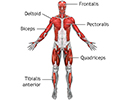Myotonia congenita
Thomsen's disease; Becker's disease
Myotonia congenita is an inherited condition that affects muscle relaxation. It is congenital, meaning that it is present from birth. It occurs more frequently in northern Scandinavia.
Causes
Myotonia congenita is caused by a genetic change (mutation). It is passed down from either one or both parents to their children (inherited).
Myotonia congenita is caused by a problem in the part of the muscle cells that are needed for muscles to relax. Abnormal repeated electrical signals occur in the muscles, causing a stiffness called myotonia.
Symptoms
The hallmark of this condition is myotonia. This means the muscles are unable to quickly relax after contracting. For example, after a handshake, the person is only very slowly able to open and pull away his hand.
Early symptoms may include:
- Difficulty swallowing
- Gagging
- Stiff movements that improve when they are repeated
- Shortness of breath or tightening of the chest at the beginning of exercise
- Frequent falls
- Difficulty opening eyes after forcing them closed or crying
Children with myotonia congenita often look muscular and well-developed. They may not have symptoms of myotonia congenita until age 2 or 3.
Exams and Tests
The health care provider may ask if there is a family history of myotonia congenita.
Tests include:
-
Electromyography
(EMG, a test of the electrical activity of the muscles)
Electromyography
Electromyography (EMG) is a test that checks the health of the muscles and the nerves that control the muscles.
 ImageRead Article Now Book Mark Article
ImageRead Article Now Book Mark Article - Genetic testing
-
Muscle biopsy
Muscle biopsy
A muscle biopsy is the removal of a small piece of muscle tissue for examination.
 ImageRead Article Now Book Mark Article
ImageRead Article Now Book Mark Article
Treatment
Mexiletine is a medicine that treats symptoms of myotonia congenita. Other treatments include:
- Phenytoin
- Procainamide
- Quinine
- Tocainide
- Carbamazepine
Outlook (Prognosis)
People with this condition can do well. Symptoms only occur when a movement is first started. After a few repetitions, the muscle relaxes and the movement becomes normal.
Some people experience the opposite effect (paradoxical myotonia) and get worse with movement. Their symptoms may improve later in life.
Possible Complications
Complications may include:
-
Aspiration pneumonia
caused by swallowing difficulties
Aspiration pneumonia
Pneumonia is a breathing condition in which there is swelling or an infection of the lungs or large airways. Aspiration pneumonia occurs when food, ...
 ImageRead Article Now Book Mark Article
ImageRead Article Now Book Mark Article - Frequent choking, gagging, or trouble swallowing in an infant
- Long-term (chronic) joint problems
- Weakness of the abdominal muscles
When to Contact a Medical Professional
Call your provider if your child has symptoms of myotonia congenita.
Prevention
Couples who want to have children and who have a family history of myotonia congenita should consider genetic counseling.
References
Kerchner GA, Ptácek LJ. Channelopathies: Episodic and electrical disorders of the nervous system. In: Daroff RB, Jankovic J, Mazziotta JC, Pomeroy SL, eds. Bradley's Neurology in Clinical Practice . 7th ed. Philadelphia, PA: Elsevier Saunders; 2016:chap 99.
Sarnat HB. Muscular dystrophies. In: Kliegman RM, Stanton BF, St Geme JW, Schor NF, eds. Nelson Textbook of Pediatrics . 20th ed. Philadelphia, PA: Elsevier; 2016:chap 609.
Selcen D. Muscle diseases. In: Goldman L, Schafer AI, eds. Goldman's Cecil Medicine . 25th ed. Philadelphia, PA: Elsevier Saunders; 2016:chap 421.
-
Superficial anterior muscles - illustration
Superficial muscles are close to the surface of the skin. Muscles which lie closer to bone or internal organs are called deep muscles.
Superficial anterior muscles
illustration
Review Date: 2/27/2016
Reviewed By: Amit M. Shelat, DO, FACP, Attending Neurologist and Assistant Professor of Clinical Neurology, SUNY Stony Brook, School of Medicine, Stony Brook, NY. Review provided by VeriMed Healthcare Network. Also reviewed by David Zieve, MD, MHA, Isla Ogilvie, PhD, and the A.D.A.M. Editorial team.

